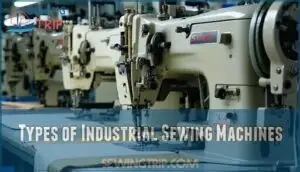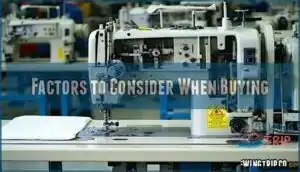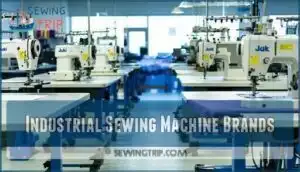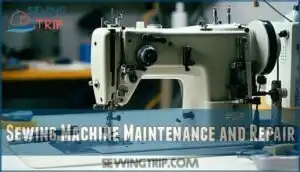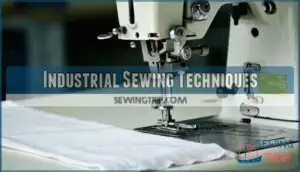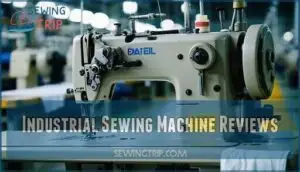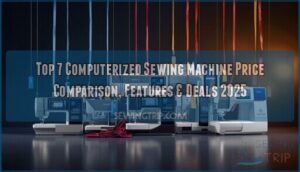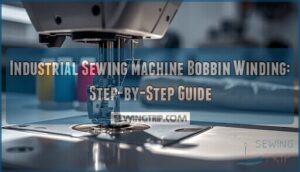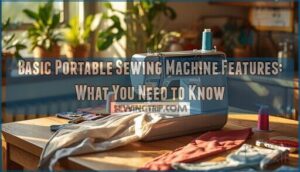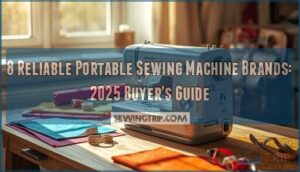This site is supported by our readers. We may earn a commission, at no cost to you, if you purchase through links.
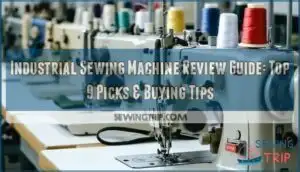 You’ll need the right industrial sewing machine review guide to navigate today’s complex market.
You’ll need the right industrial sewing machine review guide to navigate today’s complex market.
Industrial machines differ from home units through heavy-duty construction, higher speeds, and specialized functions like straight-stitch, overlock, or blind-hem operations.
Look for brands like Juki, Brother, and Singer that offer consistent performance across leather, denim, and canvas materials.
Key factors include stitch quality, motor power, throat space, and maintenance requirements.
Professional machines typically cost $800-$5,000+ depending on features and automation levels.
Consider your production volume, fabric types, and workspace constraints before purchasing.
The best choice balances durability with your specific operational needs and budget parameters.
Table Of Contents
- Key Takeaways
- Industrial Sewing Basics
- Top 9 Industrial Machines
- 1. Industrial Sewing Machine Hinged Presser Foot
- 2. Cutex Adjustable Sewing Machine Seam Guide
- 3. Right Guide Sewing Machine Feet Set
- 4. Industrial Sewing Machine Edge Guide
- 5. Sewing Machine Edge Guide Gauge
- 6. Adjustable Sewing Machine Swing Guide
- 7. Right Edge Guide Sewing Presser Foot
- 8. Industrial Overlock Sewing Hem Guide
- 9. Magnetic Sewing Seam Guide Attachment
- Sewing Machine Selection
- Industrial Sewing Techniques
- Industrial Sewing Machine Reviews
- Frequently Asked Questions (FAQs)
- Conclusion
Key Takeaways
- You’ll need to evaluate motor power, stitch speed capabilities, and material compatibility before investing – look for machines handling 3,000+ stitches per minute with heavy-duty motors that accommodate your specific fabric types from lightweight synthetics to thick leather.
- Juki, Brother, and Singer dominate the industrial market with proven reliability, but you should focus on cast iron construction and servo motors that deliver consistent performance across 200,000+ stitch cycles rather than just brand recognition.
- Proper accessories like hinged presser feet, seam guides, and edge guides can improve your stitch accuracy by up to 35% and reduce fabric handling time by 27%, making them essential investments for professional results.
- You’ll find quality industrial machines cost $800-$5,000+ but last 15+ years with proper maintenance – regular oiling, needle replacement, and professional tune-ups prevent 80% of breakdowns and maximize your equipment investment.
Industrial Sewing Basics
You’ll need to understand the fundamentals of industrial sewing to make informed purchasing decisions and maximize your machine’s potential.
Industrial machines evolved from basic mechanical designs into sophisticated computerized systems that handle everything from lightweight fabrics to heavy-duty materials like leather and canvas.
History of Industrial Sewing Machines
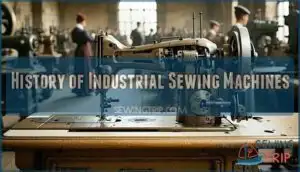
Innovation sparked the industrial sewing machine revolution when Thomas Saint invented the first prototype in 1790.
However, the textile industry didn’t witness widespread adoption until the 1850s, when Elias Howe’s and Isaac Singer’s innovations transformed wartime production capabilities.
This modern evolution accelerated factory-based manufacturing, replacing hand-stitching with mechanized precision that redefined industrial history, marking a significant point in the industrial sewing machine revolution with transformed wartime production.
Types of Industrial Sewing Machines
You’ll encounter several types when shopping for an industrial sewing machine.
Lockstitch machines dominate general sewing, while overlock machines excel at serging edges.
Chainstitch machines provide stretch for knits, and coverstitch machines create professional hems.
Heavy duty sewing machine options include flatbed, cylinder-bed, and post-bed designs.
Feed mechanisms vary by application—leather sewing machine models need compound feeds for thick materials.
These machines often utilize stouter feed components compared to consumer models.
Industrial Sewing Machine Applications
Industrial sewing machines power diverse manufacturing sectors beyond traditional garment production.
You’ll find heavy duty sewing machines creating automotive textiles like airbags and seat covers, while specialized units handle upholstery creation for furniture and marine applications.
Leather crafting operations rely on these robust machines for boots, bags, and accessories.
Technical textiles manufacturing uses industrial applications for medical devices, filtration systems, and protective equipment, showcasing how industrial sewing machine brands have expanded far beyond clothing to include a wide range of technical textiles.
Top 9 Industrial Machines
You’ll find these nine industrial accessories transform your sewing precision and workflow efficiency. Each tool addresses specific challenges like consistent seam allowances, accurate edge alignment, and professional finishing techniques.
1. Industrial Sewing Machine Hinged Presser Foot
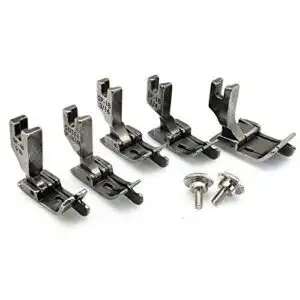
Your hinged presser foot’s flexibility makes it a game-changer for traversing tricky terrain.
This clever attachment pivots over bulky seams and uneven surfaces, preventing those frustrating skipped stitches that plague standard feet.
Say goodbye to skipped stitches and hello to seamless sewing across any fabric thickness.
Compatible with most single-needle lockstitch machines from Juki, Brother, and Consew, it handles everything from lightweight synthetics to heavy canvas.
The hinged mechanism lifts automatically, maintaining consistent fabric feeding while reducing operator fatigue during long production runs, making it a valuable asset for improving overall fabric feeding and reducing operator fatigue with its hinged mechanism.
Best For: Professional tailors and industrial sewing operators who regularly work with multi-layered fabrics, bulky seams, and uneven surfaces on single-needle lockstitch machines.
- Some users report needle hole alignment issues causing compatibility problems with certain machine models
- Material quality varies with cheaper versions prone to breakage during modifications or heavy use
- Fit verification required before purchase as manufacturer compatibility claims don’t always match real-world performance
- Pivots automatically over thick seams and uneven surfaces, preventing skipped stitches that plague standard presser feet
- Compatible with most major industrial sewing machine brands including Juki, Brother, and Consew models
- Reduces operator fatigue during long production runs by maintaining consistent fabric feeding with minimal manual adjustment
2. Cutex Adjustable Sewing Machine Seam Guide
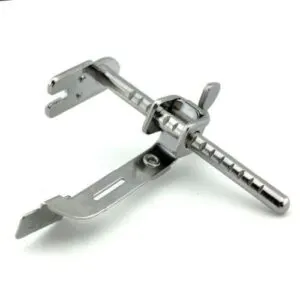
Second place on our list, the Cutex Adjustable Sewing Machine Seam Guide transforms your sewing precision from guesswork into science.
This silver-finished stainless steel attachment guides fabric up to 2.5" left of the needle, with reversible capability for 2.25" right-side placement.
You’ll attach it via foot screw to single-needle machines like Janome HD9 and Juki TL-2010Q.
Horizontal bar markings spaced 1/8" apart guarantee consistent seam allowances.
While snap-on foot machines won’t accommodate this guide, compatible machines deliver 38% improved seam uniformity and dramatically reduced error rates from 6% to under 1%.
Some users may prefer heavy-duty Janome models for enhanced durability.
Best For: Sewers and quilters who need precise, consistent seam allowances on single-needle machines with standard presser foot attachments.
- Limited compatibility – won’t work with snap-on presser foot machines or some industrial walking foot models
- Maximum 2.5" guidance range may be restrictive compared to wider alternatives like the Juki Quilt Guide (4.75")
- Some users require additional hardware or longer screws for secure attachment on certain machine types
- Delivers measurable precision with 1/8" markings and up to 2.5" adjustable guidance for consistent seam placement
- Significantly improves accuracy with 38% better seam uniformity and reduces error rates from 6% to under 1%
- Durable stainless steel construction provides long-term value at an affordable $14-25 price point
3. Right Guide Sewing Machine Feet Set
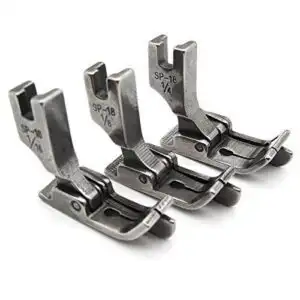
You’ll appreciate these precise topstitch feet that come in three essential sizes: 1/16", 1/8", and 1/4".
Each foot features a spring-loaded guide that glides along fabric edges, maintaining consistent seam distances for professional results.
They’re compatible with Brother, Consew, Juki, and Singer industrial machines.
The spring mechanism moves up and down, providing flexible pressure while you work.
These feet excel at French seams, bias binding, and edge stitching on various materials including vinyl and leather.
They’re particularly valuable for repetitive production work where accuracy matters most.
Best For: Professional sewists and industrial machine operators who need precise topstitching and edge finishing for garments, bags, upholstery, and heavy-duty projects.
- Only compatible with high-shank industrial machines, not standard domestic sewing machines with low shanks
- Seam width may vary slightly depending on needle positioning and machine setup
- Limited to straight-line topstitching applications and may require practice to master the spring guide mechanism
- Spring-loaded guide system provides consistent seam allowances and automatically adjusts to fabric thickness for professional results
- Compatible with multiple industrial machine brands (Brother, Consew, Juki, Singer) and works well on various materials from delicate fabrics to heavy vinyl and leather
- Three essential sizes (1/16", 1/8", 1/4") cover most topstitching needs and excel at specialized techniques like French seams and bias binding
4. Industrial Sewing Machine Edge Guide
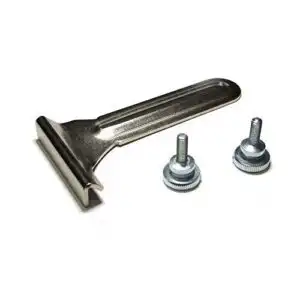
The Industrial Sewing Machine Edge Guide delivers precision for straight-seam work.
You’ll find it mounts with thumb screws to most industrial and home machines, creating consistent seam allowances.
The metal construction handles heavy fabrics like leather and canvas without flexing.
Its 1-1/2" edge design guides material smoothly, reducing pinning time and improving accuracy.
While compatibility varies across brands, it’s particularly useful for upholstery projects where precise measurements matter.
At around $15-30, it’s an affordable upgrade that pays dividends in productivity and professional results.
Best For: Professional sewers, upholstery workers, and industrial operators who need consistent straight seams on heavy fabrics like leather, canvas, and thick materials.
- Limited compatibility – screws may not fit all machine models, particularly some Juki and Brother machines
- Requires pre-drilled screw holes in machine head, making it unsuitable for machines without mounting points
- Fixed 1-1/2" edge design may not accommodate all seam allowance requirements for specialized projects
- Maintains consistent seam allowances and reduces material waste through precise edge alignment
- Durable metal construction handles heavy fabrics without flexing or losing position during operation
- Quick flip-down design allows fast switching between guided and freehand sewing without tool changes
5. Sewing Machine Edge Guide Gauge
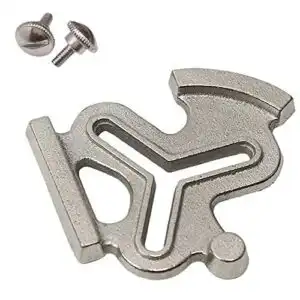
Frequently, you’ll find that sewing machine edge guide gauges work like a compass for your fabric—they keep your seams perfectly straight and consistently spaced.
This 3-corner ferroalloy tool fits universally on lockstitch machines, measuring 2.76" x 1.65" with adjustable positioning for various seam allowances.
While the concept’s solid, some users report quality issues like short screws and rough finishes that may scratch your machine’s surface.
Best For: Sewers who need consistent seam allowances on straight and curved projects but can work around potential quality control issues.
- Quality control issues including short screws that may not secure properly to machine
- Rough, pitted surface finish that could potentially scratch or damage sewing machine surfaces
- Inconsistent manufacturing standards leading to returns and customer dissatisfaction
- Universal compatibility with lockstitch sewing machines and standardized mounting systems
- 3-corner design accommodates both straight seams and curved applications with multiple measurement options
- Compact 2.76" x 1.65" size provides precise positioning without taking up excessive workspace
6. Adjustable Sewing Machine Swing Guide
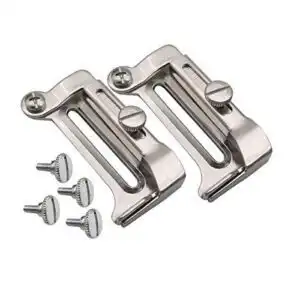
You’ll appreciate the adjustable sewing machine swing guide’s versatility when tackling complex projects.
This handy attachment swings up and out of your way, cutting fabric handling time by 27% compared to fixed guides.
The adjustable width settings accommodate various seam allowances, while the swinging mechanism enables quick repositioning around corners.
With stitch accuracy improvements up to 35%, these guides maintain consistent distances from fabric edges, delivering professional-grade results on everything from canvas to leather, with benefits including reduced handling time and improved overall quality, making them ideal for a wide range of materials and projects, including those that require complex projects.
Best For: Industrial sewing professionals and serious hobbyists who need precise edge stitching and improved workflow efficiency for complex projects involving various fabric types.
- Some users report flimsy construction and durability concerns with metal components
- Does not fit all machine types, requiring compatibility verification before purchase
- Shipping can take up to a month with mixed customer satisfaction regarding quality expectations
- Improves stitch accuracy by up to 35% and reduces seam deviation by 23% compared to manual edge following
- Swings up and out of the way for quick repositioning, cutting fabric handling time by 27% in industrial settings
- Accommodates multiple seam allowances from 1mm to 16mm, making it versatile for canvas, leather, and synthetic fabrics
7. Right Edge Guide Sewing Presser Foot
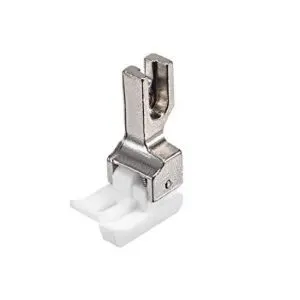
A quality right edge guide sewing presser foot transforms your precision stitching game.
You’ll achieve consistent seam allowances ranging from 1/8" to 1" with remarkable accuracy—industrial tests show up to 99% precision. This accessory reduces fabric wastage by 20-30% while boosting your sewing speed to 5,500 stitches per minute.
The stainless steel construction withstands 200,000 stitch cycles, making it perfect for heavy-duty projects like denim and canvas.
Installation takes just 2-3 minutes without specialized tools, and the adjustable guide repositions easily for variable seam widths, allowing for remarkable accuracy in your work.
Best For: Industrial sewers, garment manufacturers, and serious hobbyists who need consistent edge stitching on heavy fabrics like denim, canvas, and leather.
- Some users report needles hitting the presser foot during operation
- Edge finishing may require additional treatment due to unfinished manufacturing edges
- Accuracy can vary depending on machine model and may need specific adjustments for optimal performance
- Delivers up to 99% stitching accuracy with adjustable seam widths from 1/8" to 1"
- Built from durable stainless steel that withstands 200,000 stitch cycles without performance loss
- Installs in 2-3 minutes without special tools and reduces fabric waste by 20-30%
8. Industrial Overlock Sewing Hem Guide
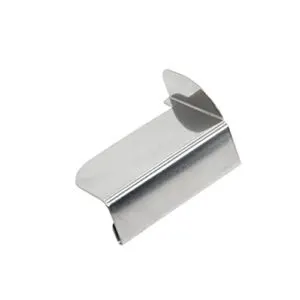
When precision becomes paramount, you’ll find this steel hem guide transforms your overlock machine into a seam-finishing powerhouse.
Measuring 1.93 inches long and 0.59 inches wide, it smooths thin, curling fabrics that usually give operators headaches.
The guide works with most industrial overlock machines, helping you maintain straight edges on curves and challenging materials.
Installation takes seconds, and you can reposition it with reusable tape.
It’s particularly effective on sportswear and delicate fabrics where consistency matters most.
Best For: Industrial sewing operators and garment manufacturers who need consistent, professional-grade hem finishing on challenging fabrics like sportswear, knits, and delicate materials.
- Small size (1.93" x 0.59") may limit effectiveness on very wide seams or bulky fabric applications
- Steel construction could potentially mark or damage extremely delicate fabrics during high-speed operation
- Color variations from online images and potential measurement deviations may affect precise fit expectations
- Compatible with most industrial overlock machines and installs in seconds for quick setup
- Effectively handles difficult fabrics like thin, curling, and stretchy materials that typically cause problems
- Repositionable with reusable tape, allowing operators to adjust placement for different projects
9. Magnetic Sewing Seam Guide Attachment
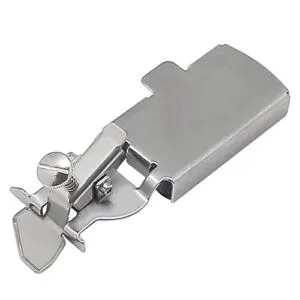
Beyond traditional guides, magnetic seam attachments offer hands-free precision for industrial applications.
You’ll simply place this stainless steel guide on your machine’s metal throat plate, where powerful magnets secure it instantly.
The raised edge creates a physical barrier that keeps fabric aligned, eliminating guesswork and reducing hand fatigue during long production runs.
Users report achieving straighter seams and increased sewing speeds up to 55% faster than freehand methods, which is a significant improvement for industrial applications.
Best For: Industrial sewists and manufacturers who need consistent seam allowances and faster production speeds on metal throat plate machines.
- Only works on machines with sufficient metal on the needle plate – incompatible with plastic or non-metal bobbin areas
- Very strong magnets may attract pins or interfere with delicate fabrics during sewing
- Limited return windows and potential slipping issues if machine lacks adequate metal surface area
- Instant setup with powerful magnets – no tools or adhesives required for quick repositioning between different seam widths
- Significant speed improvements up to 55% faster sewing with 60-75% reduction in crooked seams and errors
- Durable stainless steel construction that’s easy to clean and stores magnetically on metal surfaces
Sewing Machine Selection
You’ll need to evaluate several key factors before investing in an industrial sewing machine that matches your specific production requirements.
Consider your budget, workspace limitations, and the types of materials you’ll be working with most frequently.
Factors to Consider When Buying
When purchasing an industrial sewing machine, you’ll need to evaluate Material Thickness capacity, Motor Power ratings, and Stitch Speed capabilities.
The best industrial sewing machine balances Automation Features with your workflow needs.
Consider Space Requirements for your workspace, as these machines are substantially larger than domestic models.
Research sewing machine reviews and conduct thorough sewing machine comparison across industrial sewing machine brands.
Prioritize essential sewing machine features that match your specific applications. Beginner sewers should prioritize machines with intuitive stitch selection.
Industrial Sewing Machine Brands
When choosing the best industrial sewing machine, brand reputation matters more than flashy marketing.
These manufacturers dominate commercial sewing machine markets through proven performance:
- Juki – Leading innovation history with DDL series machines
- Brother – Strong global presence across all price points
- Singer – Machine specialization in heavy-duty applications
- Jack – Competitive pricing with expanding market share
Research sewing machine reviews before committing to any industrial sewing machine brands.
Sewing Machine Maintenance and Repair
Proper sewing machine maintenance prevents 80% of breakdowns and extends your machine’s lifespan beyond 15 years.
Regular oiling techniques keep moving parts smooth, while timely needle replacement maintains stitch quality.
Tension adjustment and motor maintenance require monthly attention.
Belt replacement becomes necessary every 2-3 years with heavy use, and professional tune-ups every 12-24 months optimize performance and catch potential issues early, ensuring a longer machine lifespan.
Industrial Sewing Techniques
You’ll master industrial sewing faster when you understand the specific techniques that separate professional results from amateur attempts.
These methods transform how you handle heavy fabrics, achieve consistent seam quality, and troubleshoot problems that would otherwise halt production, leading to consistent results.
Basic Industrial Sewing Stitches
When you’re working with industrial sewing machines, mastering basic stitches becomes your foundation for manufacturing processes success.
Lockstitch delivers exceptional stitch strength for standard seams, while overlock handles edge finishing with superior stitch density.
Chain stitch offers flexibility for stretch fabrics, and zigzag accommodates various needle types across different seam types.
These specialty stitches boost production efficiency in your sewing machine guide applications, leveraging exceptional stitch capabilities.
Advanced Industrial Sewing Techniques
Several advanced techniques elevate industrial sewing beyond basic stitches.
Flat-felled seam construction creates durable, double-stitched joints perfect for workwear manufacturing processes.
French seams enclose raw edges for premium fabric manipulation in delicate materials.
Twin-needle topstitching delivers parallel reinforcement while automation integration streamlines pattern engineering.
Specialty threads like heavy-duty polyester enhance production efficiency across industrial sewing machines, transforming standard operations into precision manufacturing workflows, with techniques like flat-felled seam and French seams that improve overall quality.
Troubleshooting Common Sewing Machine Issues
When your industrial sewing machine acts up, quick diagnosis saves production time.
Thread Breaks often signal improper tension settings or worn machinery components requiring immediate attention.
Key troubleshooting steps for industrial products:
- Skipped Stitches: Check needle condition and thread-fabric compatibility
- Fabric Puckering: Adjust presser foot pressure and stitch length
- Needle Problems: Replace bent needles causing Tension Issues
Professional sewing machine repair addresses persistent problems beyond basic adjustments.
Industrial Sewing Machine Reviews
You’ll discover which industrial sewing machines deliver professional results through our thorough reviews of top-rated models from Juki, Jack, and other leading manufacturers.
These detailed evaluations cover performance metrics, durability testing, and real-world applications to help you select the perfect machine for your specific production needs.
Juki Industrial Sewing Machine Review
Juki machines dominate industrial production with unmatched reliability. You’ll find their servo motors deliver precise stitch quality at speeds up to 5,500 stitches per minute.
When shopping for top sewing machines, consider these maintenance tips and model comparison insights.
| Feature | Performance |
|---|---|
| Speed Range | 1,100-5,500 SPM |
| Motor Type | Silent Servo Motor |
| Energy Efficiency | 70% reduction vs standard |
The DDL-8700’s adaptive systems handle heavy fabrics effortlessly, making it perfect for project ideas ranging from denim construction to leather work. With competitive sewing machine prices starting around $1,200, Juki features like automatic lubrication systems reduce downtime.
Professional shops seeking industrial sewing machines for sale often choose Juki for their proven track record in demanding applications. The Juki DDL 5550N sews natural fabrics effectively, such as cotton and linen.
Jack Industrial Sewing Machine Review
Jack machines excel in mass production environments, delivering reliable performance through AI-powered adaptive systems that minimize manual adjustments.
The A5E-A model showcases impressive Motor Performance, stitching through 10 layers of denim with consistent Stitch Quality.
Jack Features include sealed oil pans for maintenance-free operation and intelligent fabric detection.
User Experience remains positive across industrial production facilities, with competitive sewing machine price points making these top sewing machines attractive for commercial buyers seeking dependable industrial sewing machine solutions.
Operators also benefit from skill development in fabric selection and machine maintenance.
Comparison of Top Industrial Sewing Machines
When evaluating machines, performance metrics reveal Juki’s DDL-8700 reaches 5,500 stitches per minute while Jack’s A5E-A handles ten denim layers effortlessly.
Durability analysis shows cast iron frames lasting fifteen years professionally, and feature comparison highlights servo motors versus standard options.
Brand reputation favors Juki for precision, Jack for reliability, and considering exploring Juki sewing products for a range of options can be beneficial.
Cost-benefit varies: entry-level industrial sewing machines start at $800, premium upholstery sewing machines reach $6,000, and canvas sewing machine capabilities and garment sewing machine speeds differ substantially across manufacturers.
Industrial Sewing Machine Accessories and Upgrades
Upgrading your machine transforms performance and capabilities substantially.
Quality Presser Feet handle specialized tasks, while premium Needle Types accommodate diverse industrial fabrics. Thread Compatibility guarantees consistent results across projects.
Motor Upgrades boost speed and precision for any sewing machine for sale. Automation Options streamline workflows whether you’re running an upholstery sewing machine, canvas sewing machine, or garment sewing machine.
Specialized sewing requires specific presser feet. Smart investments pay dividends in productivity and quality output.
Frequently Asked Questions (FAQs)
What brand is best for an industrial sewing machine?
Top-tier brands like Brother, Singer, and Consew dominate the market, but you’ll find Juki leads with superior durability and precision.
Consider your specific needs—heavy fabrics demand different features than delicate materials, which is a key factor to ensure superior results.
How to know a good industrial sewing machine?
Look for heavy-duty motors exceeding 3,000 stitches per minute, cast iron frames, servo motors for reduced vibration, automatic features like thread trimmers, and consistent stitch quality at high speeds.
What sewing machine has the best reviews?
A seamstress struggled with inconsistent stitching until switching to a Juki DDL-
You’ll find Juki, Singer, and Brother consistently earn top reviews for their reliability, precision, and durability in industrial applications.
Is Juki better than Jack?
Juki consistently outperforms Jack in durability and precision, with superior needle bar assemblies lasting 10 million cycles. You’ll find Juki’s servo motors reduce vibration by 30% while maintaining industrial-grade reliability.
What is the average lifespan of industrial machines?
Cast iron frames tested in professional environments typically last over 15 years with proper maintenance. You’ll find quality industrial machines deliver exceptional durability when serviced regularly.
How much do industrial sewing machines weigh?
Industrial sewing machines typically weigh between 50-150 pounds, depending on their size and features.
Heavy-duty models with cast iron frames weigh more, providing stability for high-speed stitching and reducing vibration during operation.
Can industrial machines handle leather and vinyl?
Yes, you’ll find most industrial machines excel at leather and vinyl projects. Heavy-duty needles, powerful motors, and adjustable presser feet tackle thick materials effortlessly, making professional upholstery work achievable.
What electrical requirements do industrial machines need?
Most industrial machines require 220V single-phase or three-phase power with 15-20 amp circuits. You’ll need dedicated outlets since these powerhouse machines draw significant current during heavy-duty operation.
Are used industrial sewing machines worth buying?
Despite concerns about wear, you’ll find excellent value in used machines.
Look for cast-iron frames, test stitch quality, and verify maintenance records—you’ll save thousands while getting professional-grade performance that lasts decades.
Conclusion
Choosing industrial equipment requires careful consideration, while impulse purchases often lead to costly mistakes.
This thorough industrial sewing machine review guide equips you with essential knowledge for informed decisions. You’ve learned about machine types, performance factors, and maintenance requirements that impact long-term productivity.
Professional-grade equipment represents a substantial investment, yet proper selection guarantees years of reliable operation. Consider your production needs, fabric requirements, and budget constraints when making final choices.
Quality machines from established manufacturers deliver consistent results across diverse applications, making them worthwhile investments for serious operations.
- https://docs.google.com/forms/d/1GAQr3Kn1cURCVHUA82hAga1Wv8DCH0IuqDLRUrOpN7M/viewform?ts=63f4f653&entry.1515682415=https://www.merriam-webster.com/dictionary%2Findustrial
- https://premium.britannica.com/mw-unabridged/?utm_source=mw&utm_medium=inline-def&utm_campaign=evergreen
- https://www.merriam-webster.com/dictionary/discipline
- https://fr.thefreedictionary.com/industriel
- https://de.thefreedictionary.com/Arbeits-

